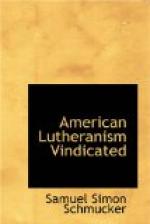2. In his letter to Lazarus Spengler, in 1528, Luther observes this same distinction. “In the first place,” he remarks, “it is unreasonable that any one should be forced to receive the sacrament or to abstain from it.” And he adds: “All masses, at which there are no communicants” (that is, at which the sacrament is not administered,) “should absolutely be omitted.” [Note 12] Here the administration of the supper to the laity is termed sacrament, and that service performed by the minister, which was sometimes succeeded by the sacrament or communion, and at others not, is called mass.
3. The Counsel of Luther and Pomeranius, in 1528, to Duke George: “First, as you inquire concerning parish masses, &c. Be it known to you that no minister can with good conscience perform mass alone, when there are no communicants. Therefore here there is no room for further inquiry; either there must be communicants, or them should be no mass.” [Note 13]
4. Luther’s “Confession of the Christian Doctrines, in XVII. Articles,” published in 1530. This is a very short Confession, each article containing but three or four sentences, and the whole amounting to only three or four 8vo. pages. In Article X. he says: “The eucharist or sacrament of the altar also consists of two parts, namely that the true body and blood of Christ should verily be present in the bread and wine;” and in Article XVI. he says: “Above all other abominations, the masses, that have hitherto been regarded as a sacrifice or good work, by which one designed to procure grace for the other, are to be rejected.” [Note 14] Here the distinction is not only made between the mass and eucharist, but the doctrine of the mass as a sacrifice of Christ offered by the priest for others, is also denounced. It will also be recollected that this view of the mass as a sacrifice, and as vicarious, is strongly denounced in the Augsburg Confession, whilst the charge of having rejected the rite itself




